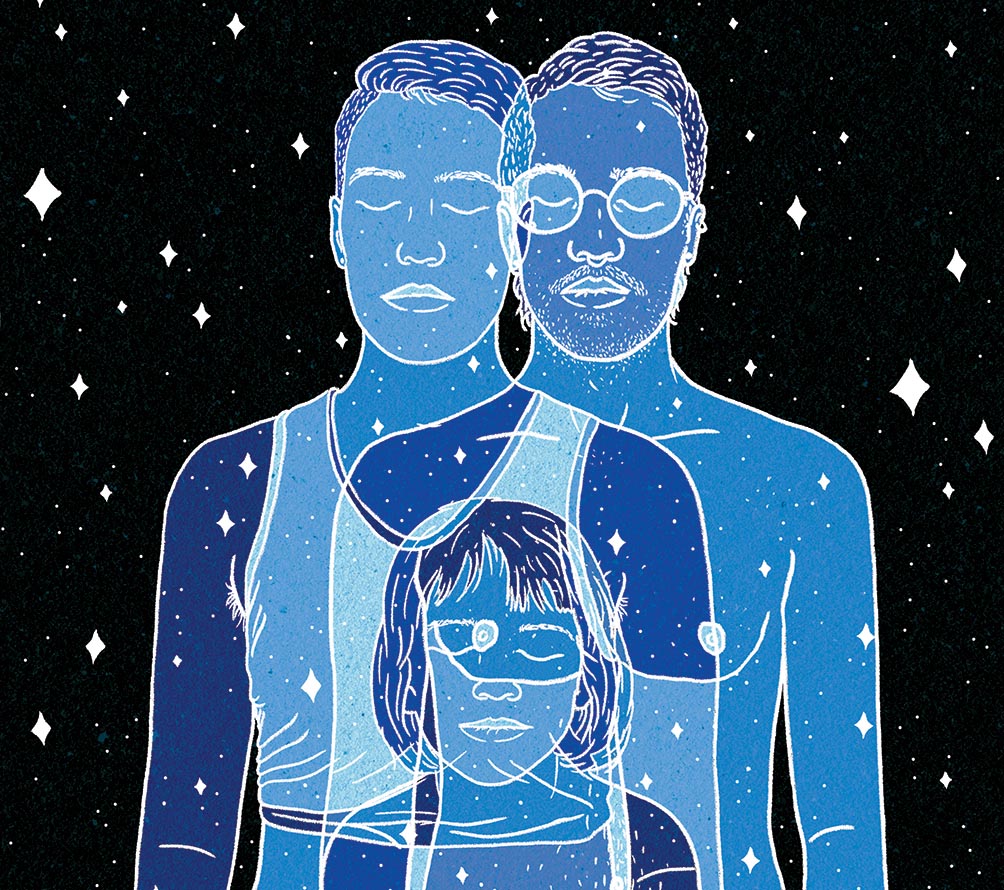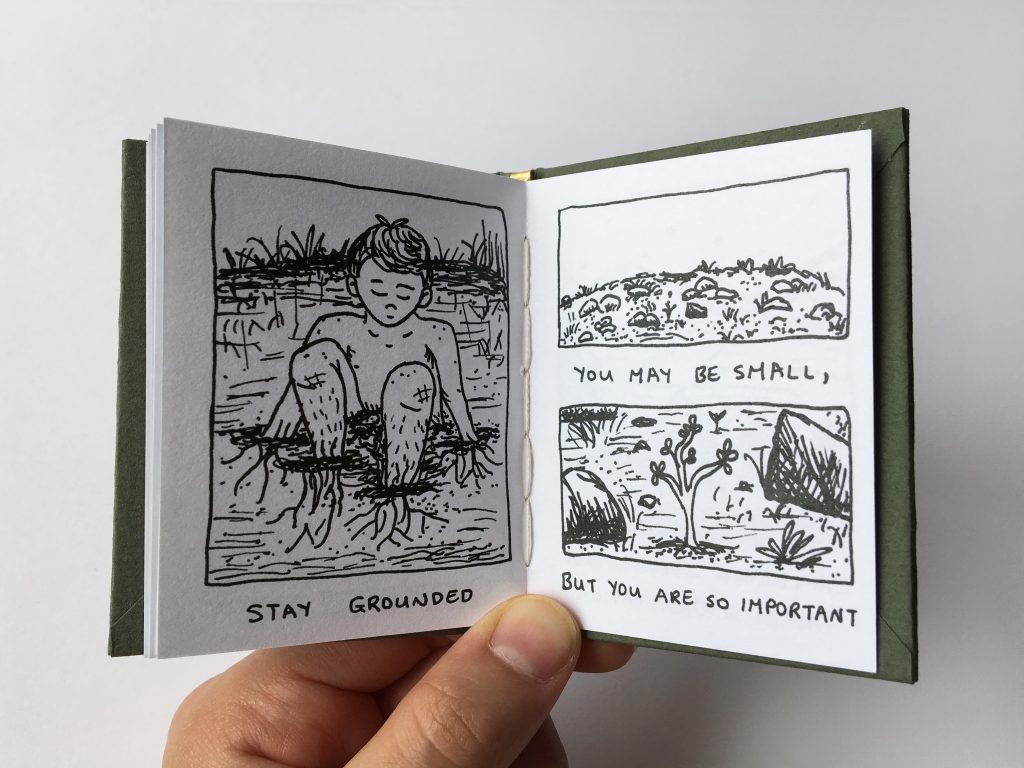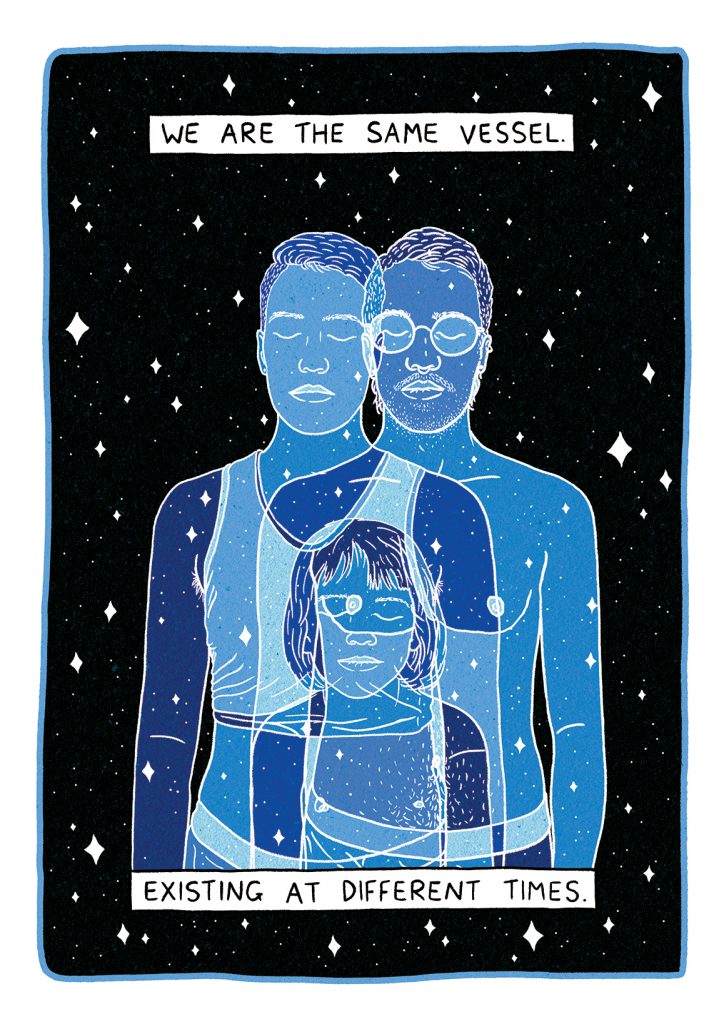Illustrator Samuel Luke Explores Gender Through Autobiographical Comics
With cosmic illustrations, this Australian artist delves into identity, tomboyhood and the trans experience for himself and an audience of all ages

When Samuel Luke Beatty began his Fine Arts degree at the University of New South Wales in 2014, his work consisted almost entirely of the same self-portrait: a close-cropped drawing of his head and shoulders, repeated ad infinitum through a myriad of media. But in the years since, this self-depiction has taken on a far more intimate quality. Beatty, now working as a freelance illustrator and creating autobiographical art under the moniker Samuel Luke, uses the medium of digital science fiction comics to create sophisticated, chromatic expressions of the gay, transgender man’s experience.
Luke has participated in over 20 art exhibitions in Australia and Canada (including two solo shows in Sydney, Gay Boy and Body in Retrograde) and designed sneakers for Converse. His deeply personal work explores his experiences with medical and social gender transition, queer sexuality and the body as self. He often uses outer space as a neutral, genderless substrate in which to explore themes of transition, identity, queerness and manhood. Nevertheless, Luke’s art is grounded in the vulnerability of his own lived experiences. We spoke with the artist about how he developed this quality in his artistic practice.

Your visual art practice interacts with your identity—especially as a transgender person—how has that developed over the course of your career so far?
They very much go hand in hand. When I started university in 2014, I looked a lot different than I do now. I had discovered the language of what transgender was when I was in high school, but I wasn’t ready to come to terms with that and wasn’t addressing it at all. But when I was at university, that was a time when I felt comfortable to explore my identity, so that was when I came out as trans.
I was at art school, so a very supportive environment. After I officially came out, every single artwork that I made was about my trans identity. When we were given a brief, I would always twist it to be about being trans. What’s the point of going to university, if you’re not making art that you want to make?
Your art explores deeply personal topics—what inspires you to share these experiences from your own life?
 A lot of it comes from a personal need—from not seeing that kind of work when I needed to see it. When I was trying to grasp onto language to articulate how I felt about my body and my identity, I would feel really left out of this very set narrative of what a trans guy is, and what gender dysphoria is. Am I weird for feeling uncomfortable even though I’ve had top surgery? Why am I still uncomfortable being addressed as a man? It takes so long to get used to these massive changes. And these sorts of topics, I didn’t see talked about at all. So I was like, “I’m going to talk about them then.” I mainly made the art for myself and what I would want to see.
A lot of it comes from a personal need—from not seeing that kind of work when I needed to see it. When I was trying to grasp onto language to articulate how I felt about my body and my identity, I would feel really left out of this very set narrative of what a trans guy is, and what gender dysphoria is. Am I weird for feeling uncomfortable even though I’ve had top surgery? Why am I still uncomfortable being addressed as a man? It takes so long to get used to these massive changes. And these sorts of topics, I didn’t see talked about at all. So I was like, “I’m going to talk about them then.” I mainly made the art for myself and what I would want to see.

Do you think that over time you might move away from telling stories that are so personal? For example, would you ever make art about other individuals, other transgender people, or fictional characters?
That’s very interesting. I think I would love to have a fictional character and pursue a fictional universe, but I feel like in some ways it would always be reflective of me. I would always draw inspiration from my experiences or feelings. I do really enjoy the autobiographical part of storytelling—it’s super-empowering and a really wonderful way for me to say what I’ve been through, often not using many words. Especially with my latest work, in Gay Boy Issue 2. Those ones use very limited words, especially the one about socks. “I kept my socks on, but I wish I’d kept my binder on.” I like using very limited words to capture super-complex feelings.
Are you exploring new mediums or evolving your work in other ways?
 I’m learning how to quilt at the moment. The quilt will be a collection of childhood symbols and items that I had as a kid that affirmed my gender under the safety of being a tomboy. During these periods of restrictions and lockdowns, instead of just reflecting on my immediate trans experience of hormones or surgery, I reflected even further and went back to childhood stuff. This time alone helped me reflect on those simpler times.
I’m learning how to quilt at the moment. The quilt will be a collection of childhood symbols and items that I had as a kid that affirmed my gender under the safety of being a tomboy. During these periods of restrictions and lockdowns, instead of just reflecting on my immediate trans experience of hormones or surgery, I reflected even further and went back to childhood stuff. This time alone helped me reflect on those simpler times.
Also, during my thesis year, I was able to draw myself as a future self, in a future body, and now I embody that future body. I am that future body. Which is a really cool full-circle moment. I feel like I don’t talk about that very often. I’d like to unpack that a bit more.

Do your comics have an intended audience?
I started out my thesis project wanting to make a children’s book for young trans kids that would affirm them and reassure them. It was called How to be a Gender Explorer. This little gender explorer character is navigating through outer space, and they’re trying to grasp onto anything, really. They’re floating around space and jumping between planets, and the narration of the comic is like, “I hope you find support, you are loved, you are…” and it’s very much addressing the reader. It was ‘for’ someone else.
 But the more I worked on that project, about halfway through the first semester, the narration switched. It started being like, “I feel out of orbit” or “I feel lost,” and I inserted myself into the narrative. I feel like the “you” was either a younger me or even a current me, needing to hear that validation. I wrote that book during a time when I wasn’t able to transition medically. I’d been out as trans for three years, which at the time felt like such a long time, and I wasn’t even able to come out fully to my extended family. So it was a very complicated time and very frustrating, and I essentially made the book as an outlet for all those feelings.
But the more I worked on that project, about halfway through the first semester, the narration switched. It started being like, “I feel out of orbit” or “I feel lost,” and I inserted myself into the narrative. I feel like the “you” was either a younger me or even a current me, needing to hear that validation. I wrote that book during a time when I wasn’t able to transition medically. I’d been out as trans for three years, which at the time felt like such a long time, and I wasn’t even able to come out fully to my extended family. So it was a very complicated time and very frustrating, and I essentially made the book as an outlet for all those feelings.
Is it important to you that people relate to your work?
I think a good example of this is one of my recent comics, the one about tomboyhood. That one is very much just me: childhood photos of me, my childhood toys, and my childhood interests that are super-niche. I created that for me. But I try to invite people in, which is what I love to do: I love telling stories. I hope people enjoy listening to the stories, and it’s such a beautiful bonus when they relate to it as well.
Images courtesy of Samuel Luke












